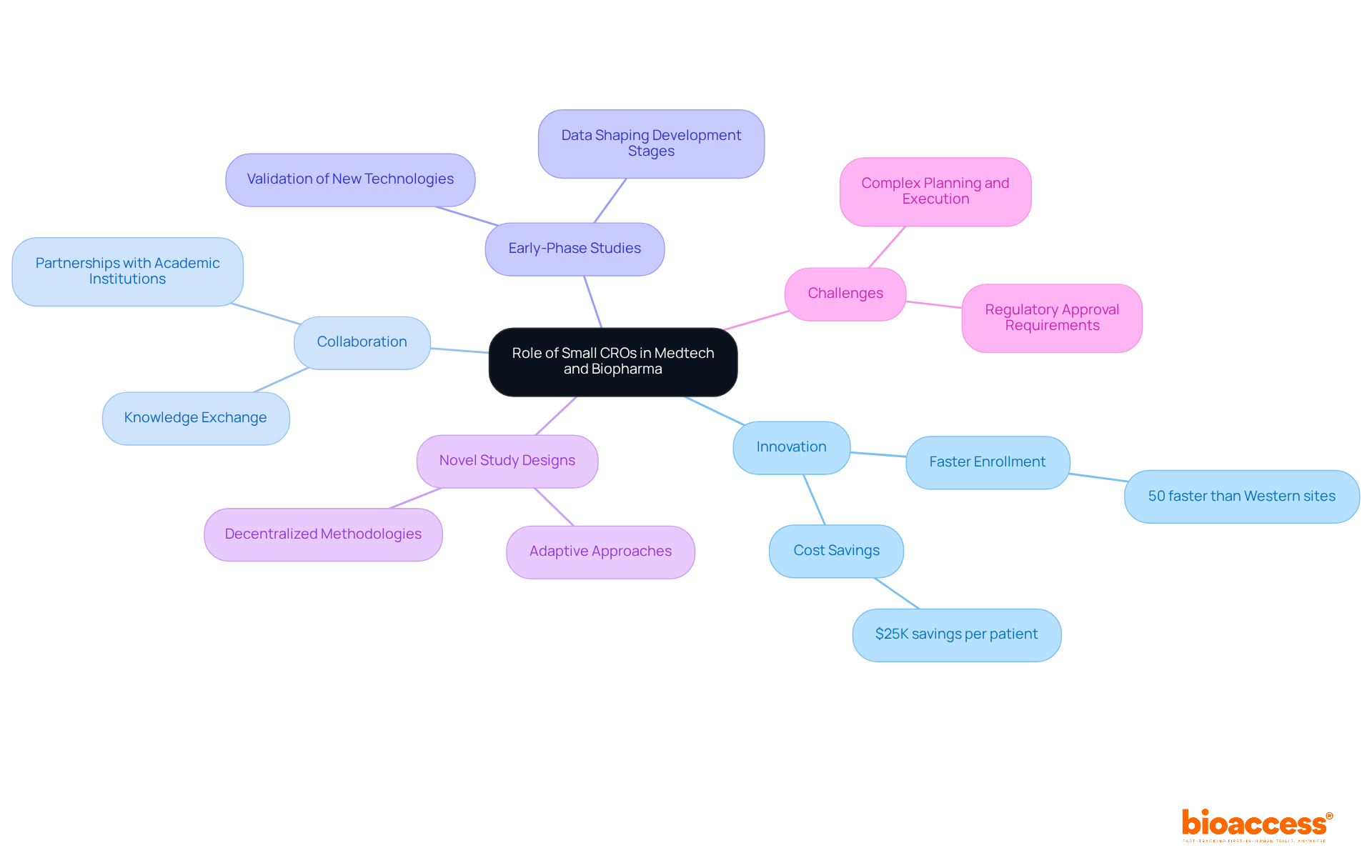


Small clinical research organizations (CROs) are transforming the landscape of medical research, especially in dynamic markets like Colombia. Their unique advantages—agility, customized services, and cost-effectiveness—position them as pivotal players in accelerating innovation within the Medtech and Biopharma sectors. What truly distinguishes these smaller entities is their ability to navigate complex challenges and adopt novel methodologies. This raises a compelling question: how can small CROs continue to drive significant advancements in clinical research while competing against larger organizations?
Small clinical research organizations (CROs) provide unique benefits that improve their efficiency in the research landscape, especially in Colombia. Their agility stands out as a significant benefit; smaller teams can swiftly adapt to changes in project scope or regulatory requirements, fostering a more flexible approach to clinical studies. This adaptability often leads to quicker decision-making processes, which is vital in the fast-paced realms of Medtech and Biopharma. In Colombia, the total review time by IRB/EC and MoH (INVIMA) is just 90-120 days, greatly accelerating the initiation of studies.
Moreover, small clinical research organizations typically provide customized services, cultivating closer relationships with clients. This direct communication fosters collaboration and ensures that the unique needs of each project are addressed with precision. The capacity to deliver tailored solutions is especially advantageous for startups and smaller firms that may operate on tight budgets yet require high-quality research services. With biopharma funding surging by 56% earlier this year, the demand for cost-effective solutions has never been more urgent.
Additionally, small clinical research organizations often maintain lower overhead costs, which enables them to offer competitive pricing without sacrificing quality. This cost-effectiveness is particularly attractive to emerging biopharma companies aiming to optimize their resources. Furthermore, small CROs can concentrate on niche areas of expertise, enabling them to cultivate specialized knowledge essential for executing complex studies. Colombia's R&D tax incentives, which include a 100% tax deduction and various financial benefits, further enhance the appeal of conducting research in the country. Their focus on specific therapeutic areas increases their attractiveness to clients seeking innovative research methodologies, ultimately driving progress within the industry.

Small clinical research organizations are adept at accelerating clinical study timelines through a range of strategic practices, primarily due to their streamlined operational processes. With fewer bureaucratic layers, these organizations can make swift decisions, enabling rapid adjustments to study protocols and patient recruitment strategies. This agility is especially crucial during initial-phase evaluations, where time is of the essence.
Moreover, small clinical research organizations leverage advanced technologies and sophisticated data management systems to enhance operational efficiency. By utilizing digital tools for patient recruitment and data collection, they significantly reduce the time spent on administrative tasks, allowing researchers to focus on core study activities. For instance, bioaccess® employs FDA-ready data to achieve patient enrollment 50% faster than traditional sites, resulting in substantial cost savings of $25K per patient. This approach exemplifies how small clinical research organizations can expedite research studies while maintaining high standards of data integrity.
Additionally, small clinical research organizations often cultivate strong relationships with local sites and investigators, streamlining site activation and patient enrollment processes. Bioaccess's partnership with Caribbean Health Group aims to establish Barranquilla as a leading location for medical studies in Latin America, supported by Colombia's Minister of Health. Their deep understanding of regional regulatory environments allows them to navigate approvals more efficiently, further compressing timelines. This collaboration underscores the importance of stakeholder involvement—including sponsors, investigators, and regulatory bodies—in effective study management.
Furthermore, the growing demand for tailored healthcare and global studies positions small clinical research organizations advantageously within the evolving landscape of medical research. The '6-8 Week Sprint Approach' for cardiology and neurology groups illustrates how operational efficiency, localized expertise, and collaborative strategies position niche organizations like bioaccess® as pivotal players in expediting the trial process, ultimately driving innovation in the Medtech, Biopharma, and Radiopharma sectors.

Small clinical research organizations are essential drivers of innovation in the Medtech and Biopharma sectors, leveraging their specialized expertise to meet the unique demands of emerging companies. Their involvement in early-phase studies is particularly significant, as these studies are crucial for validating new technologies and therapies, providing vital data that shapes subsequent development stages. For instance, bioaccess® enables treatment-naive cardiology or neurology cohorts to enroll 50% faster than Western sites, achieving $25K savings per patient with FDA-ready data—no rework, no delays. This illustrates the flexibility and quickness of small clinical research organizations in conducting clinical studies.
Furthermore, small clinical research organizations often take the lead in embracing novel study designs, including adaptive and decentralized approaches. These methodologies not only improve patient engagement but also enhance data quality, allowing for more responsive and efficient research processes. The inherent flexibility of small clinical research organizations enables them to explore innovative approaches that larger organizations may avoid due to stringent protocols.
Collaboration is another hallmark of small clinical research organizations, as these organizations often partner with academic institutions and research entities. This synergy fosters an environment ripe for knowledge exchange and innovation, leading to groundbreaking research outcomes and the development of new therapeutic strategies. For instance, bioaccess® has enabled Avantec Vascular's first-in-human research in Latin America, demonstrating its ability to handle complex trials efficiently.
However, while adaptive designs offer numerous advantages, they also introduce complexities in planning and execution, requiring careful statistical planning and regulatory approval. By championing innovative practices and nurturing collaborative efforts, small clinical research organizations such as bioaccess® play a pivotal role in advancing clinical research within the Medtech and Biopharma industries.

Small clinical research organizations (CROs) play a crucial role in driving innovation within the Medtech and Biopharma sectors, thanks to their distinct advantages. Their agility, customized services, and cost-effectiveness make them invaluable partners for companies navigating the complexities of clinical research. By streamlining processes and fostering close collaborations, small CROs not only expedite trial timelines but also ensure that the specific needs of each project are meticulously met.
The benefits of small CROs are significant. Their ability to adapt quickly to regulatory changes, combined with lower operational costs, enables them to provide tailored solutions that are especially beneficial for startups and smaller firms. Furthermore, their expertise in niche therapeutic areas and advanced data management systems greatly enhance the efficiency and quality of clinical trials. Collaborative efforts between small CROs and local institutions further accelerate the research process, facilitating faster patient enrollment and study initiation.
Given these insights, the importance of small clinical research organizations in fostering innovation cannot be overstated. As the demand for efficient and effective clinical research continues to grow, embracing the advantages offered by small CROs becomes essential for companies aiming to thrive in an increasingly competitive landscape. By leveraging their specialized knowledge and adaptive strategies, organizations can achieve groundbreaking advancements in healthcare, ultimately benefiting both patients and the industry as a whole.
What are the main advantages of small clinical research organizations (CROs) in Colombia?
Small CROs in Colombia offer agility, allowing them to quickly adapt to changes in project scope or regulatory requirements, leading to faster decision-making processes. They also provide customized services and maintain closer relationships with clients.
How does the review time for studies in Colombia benefit small CROs?
In Colombia, the total review time by IRB/EC and MoH (INVIMA) is just 90-120 days, which accelerates the initiation of studies, benefiting small CROs by enabling quicker project starts.
Why are customized services important for small CROs?
Customized services foster direct communication and collaboration, ensuring that the unique needs of each project are precisely addressed, which is especially beneficial for startups and smaller firms with tight budgets.
How do small CROs manage to offer competitive pricing?
Small CROs typically have lower overhead costs, allowing them to provide competitive pricing without sacrificing quality, which is attractive to emerging biopharma companies.
What niche advantages do small CROs have in the research landscape?
Small CROs can focus on specific therapeutic areas, cultivating specialized knowledge essential for executing complex studies, making them appealing to clients seeking innovative research methodologies.
What financial incentives are available for conducting research in Colombia?
Colombia offers R&D tax incentives, including a 100% tax deduction and various financial benefits, enhancing the appeal of conducting research in the country for small CROs.